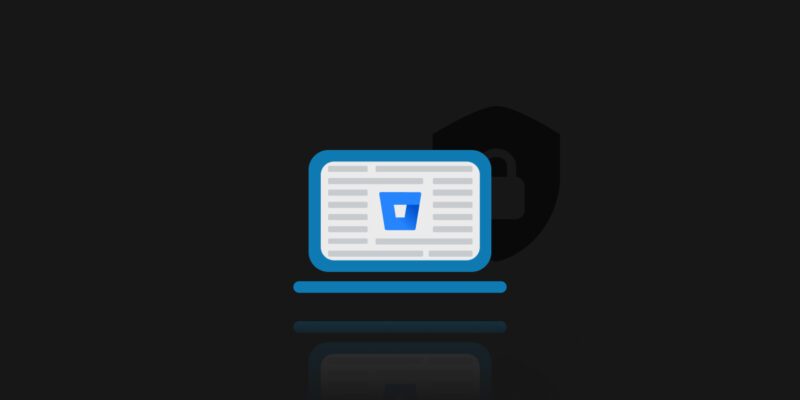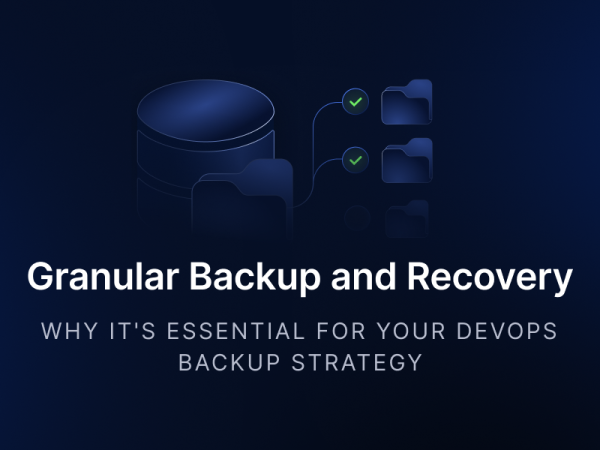
3 Best Methods to Back Up and Restore Repositories and Metadata in Bitbucket Cloud
Today, it’s a common practice for companies and their developers to use Bitbucket Cloud as a storage for vital Bitbucket data, such as documentation, source code, and history changes. It’s especially important after Atlassian’s Bitbucket Server has reached its official end-of-support in February 2024, and Atlassian’s recent announcements about the end-of-support for Bitbucket Data Center in March 2029. So, Bitbucket Data Center users have a few years to migrate their data to Bitbucket Cloud.
Why is there a need to back up the Bitbucket environment? Compliance requirements, shared responsibility, data loss… The Bitbucket data loss can lead to immense financial costs and interruption of the software development process. It’s highly probable that lost critical data cannot be recovered, which then results in a breach of security standards.
There are numerous reasons why some data protection problems can arise with recovering data stored in Bitbucket Cloud. The most common issues affecting your Bitbucket account include:
- human error
- problems with the functioning of Bitbucket services
- deletion of user accounts
- overwriting of data
- ransomware attack
To prevent these costly errors, you may consider the Bitbucket backup option. Regular Bitbucket backups are one of the most important elements of your company’s data security and compliance.
Read the following article to learn how you can back up data stored in Bitbucket. And find out about several backup methods to ensure the security of your Bitbucket repositories and related metadata.
How does Atlassian manage Bitbucket Cloud backup?
Atlassian runs automatic snapshot backups of all the data they have on its platform. Those snapshots the service provider retains for 30 days, which allows it to perform a point-in-time data restoration if needed. Sometimes outages happen even to the most trustworthy services, like Atlassian.

Let’s get back to the topic. Here, it’s worth mentioning the Shared Responsibility model. According to it, Atlassian takes care of its service availability and recoverability, and the need to backup Bitbucket repositories and metadata, therefore, falls on your company. So, it is you who is responsible for data recovery if something goes wrong with your Bitbucket environment.
How to be sure that your Bitbucket repositories and metadata are recoverable and constantly accessible? DevOps backup, which is built within the backup best practices.
What ways can you use to back up your critical repository data? Let’s zoom in on a few backup methods and see how well they preserve Bitbucket repository data and metadata.
#1 Use the git clone command
Using the git clone command is one of the easiest ways to create a backup for the data stored in Bitbucket. The cloned code repositories are copies that you can safely keep on your private server. The cloned git repositories created using this command are absolutely identical to the data kept in the cloud.
Though sometimes it can be a little bit difficult to implement the solution and store the data in local versions. Why? Because the local copy is also exposed to random events and user errors. So, when it comes to the recoverability of Bitbucket data, recovery can take some time.
To use the git clone command, you should have Git installed on your terminal. Well, as soon as you have it, use the adequately modified command:
bash
git clone <url-of-chosen-repository> <directory-for-the-copy>Check out the git-clone Documentation for more information.
#2 Use Google Cloud Source Repositories
Using Google’s service, you can create a mirror of Bitbucket (not a self-hosted Bitbucket) repositories and store them in the Google Cloud storage. This backup solution is paid and has limitations due to Google’s hosted database. By design, it is not a service intended for backup, but it can be used to copy your company’s Bitbucket repositories and, if there is a need, to have your data recovered.
To create a copy of your data in Bitbucket, get connected to Google Cloud and follow these steps:
- Open the Google Cloud service
- Go to Cloud Source Repositories
- Add an external repository
- From the Git provider list, select Bitbucket
- Connect the selected git repositories
You can read more about it in Cloud Source Repositories Documentation..
#3 Use third-party Bitbucket backup tools
Using third-party backup tools, like GitProtect.io, which is a fully manageable Bitbucket backup software, can have a lot of benefits. First, you share your responsibilities in data protection. Second, you can save your DevOps time with automatic, maintenance-free backups of all or only chosen Bitbucket repositories and metadata. When your DevOps team has to write backup scripts, they are distracted from their core duties, and it may slow down the development process.
Moreover, a third-party backup vendor’s solution, unlike Bitbucket backup scripts, can cover the entire Bitbucket environment, including repositories, wikis, issues, comments, downloads, deployment keys, pull requests, webhooks, pipelines, actions, tags, commits, branches, and Large File Storage (LFS). This approach can really instill confidence in your Bitbucket account, knowing you can go back to all the backup files at any point in time.
Another advantage is restore and Disaster Recovery opportunities ready for any disaster scenario. When you back up your data with a third-party Bitbucket backup tool, you get a guarantee that you will have your data restored quickly and without interruption of your company’s workflow. In an ideal data-loss-free world, responding to failures is much easier when you have point-in-time and granular restore, cross-over recovery to another Git hosting provider like GitHub or GitLab, or the ability to restore your Bitbucket Cloud to a self-hosted instance.
Checklist: Bitbucket Disaster Recovery Plan
Assuming your Bitbucket instance goes down, you’ll need the plan to get it backed up and running it as quickly as possible. Here’s a detailed Disaster Recovery plan for Bitbucket:
- Back up your Bitbucket data regularly. The frequency of backups will depend on how often your data changes. Tip: ensure you have automatic daily backups.
- Store Bitbucket backups in a safe location, such as an off-site server or cloud storage service.
- When disaster strikes, use the most recent backup to restore your Bitbucket environment.
- If possible, test your Disaster Recovery plan periodically to ensure that it works as expected.
Find out which disaster scenarios you need to consider while preparing your restore strategy to ensure business continuity:
Reliable backup eliminates no data loss
There are multiple methods to back up and restore git repositories and metadata in Bitbucket, ranging from manual exports to automated Bitbucket backup solutions. The best approach depends on your needs: whether you prioritize simplicity, full source code and metadata coverage, or automated backups for long-term resilience and zero data loss.
Though, don’t forget that security comes first. Your Bitbucket backup software should be more than a solution; it should be a reliable backup strategy that helps you comply with strict security standards, like SOC 2 and ISO 27001, and meet the Atlassian Cloud Security Shared Responsibility Model. It should bring peace of mind to your DevOps and security teams, leaving more time for source code development and its improvement.
GitProtect is an intuitive Bitbucket backup solution that will easily and efficiently back up your data stored in Bitbucket Cloud. It allows you to schedule automatic backups with the possibility to restore them in minutes, and it takes care of Bitbucket security. With GitProtect, you get to use unlimited retention for your Bitbucket backup, create your own encryption key for better data protection, execute a custom backup plan, and leverage automation to increase backup performance success. Create a Bitbucket backup with a 14-day free trial by signing up to get a good look and feel of the backup process using GitProtect’s visual dashboard!
The article was originally published on January 17th, 2023





